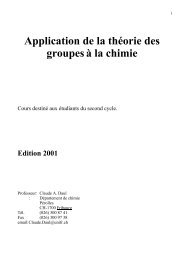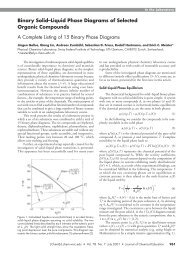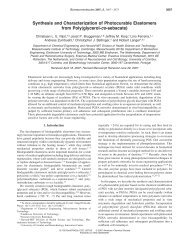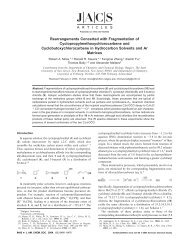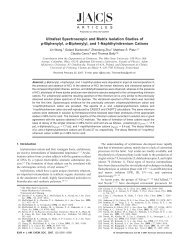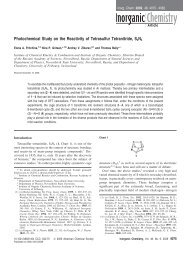Reversible Interconversion between Singlet and Triplet 2-Naphthyl ...
Reversible Interconversion between Singlet and Triplet 2-Naphthyl ...
Reversible Interconversion between Singlet and Triplet 2-Naphthyl ...
You also want an ePaper? Increase the reach of your titles
YUMPU automatically turns print PDFs into web optimized ePapers that Google loves.
L J. Am. Chem. Soc. PAGE EST: 11.5 Zhu et al.chemical loss of CO 2 to give 2-vinylnaphthalene (VN), whichunfortunately has no IR absorptions with an intensity commensuratewith that of CdO stretches, <strong>and</strong> hence it is notsurprising that it does not manifest itself clearly as a photofragment.However, in the flash photolysis studies described inthe accompanying paper of Wang et al., 16 VN was observed asa final product of the photolysis of MDA.ConclusionsOn irradiation into its weak visible absorption b<strong>and</strong>, 3 NCCis converted to a photoproduct with a broad absorption at 420nm. Concurrently, the ESR signals of 3 NCC disappear, whichindicates that the photoproduct is a singlet species. On photolysisat 450 nm or upon st<strong>and</strong>ing overnight at 12 K in the dark, 3 -NCC is re-formed almost quantitatively. We showed, by acombination of different spectroscopic <strong>and</strong> theoretical methods,that the above photoproduct is identical to the singlet state ofthe same carbene, 1 NCC, which is marginally protected fromspontaneous decay to the triplet ground state by a pronouncedconformational change of the COOMe group. The ester groupis coplanar with the naphthylcarbene moiety in 3 NCC butassumes a perpendicular conformation in 1 NCC to avoiddestabilization of the formally vacant carbenic 2p atomic orbitalby the electron-withdrawing carbonyl group. A very similar caseof “conformational control of the spin state” has recently beenfound in dimethylenenepyrrole diradicals. 108 However, to ourbest knowledge, the example of 2-naphthyl(carbomethoxy)carbeneis the first case in which a metastable singlet state <strong>and</strong> itsslow thermal conversion to the triplet ground state have beenobserved spectroscopically.Acknowledgment. This work is part of Project 2028-047212.96 of the Swiss National Science Foundation <strong>and</strong> GrantCHE-9301025 of the U.S. National Science Foundation. Weare very indebted to Prof. Matthew Platz (Ohio State University)for raising the problem of the enigmatic photoproduct of 3 NCC<strong>and</strong> for his continued interest in the resolution of the problem.We thank him as well as Prof. John Toscano (Johns HopkinsUniversity) for the open exchange of data <strong>and</strong> manuscripts whichmade it possible to present our results jointly. Finally, wegratefully acknowledge the help of Dr. Stephan Matzinger(University of Fribourg) in locating the oxirene transition statefor the NCC-NMC interconversion <strong>and</strong> for the IRC calculationson the phenyl derivative.Supporting Information Available: Tables containing theB3LYP/6-31G* optimized Cartesian coordinates, total energies,<strong>and</strong> thermal corrections of all stationary points (minimums <strong>and</strong>transition states) discussed in this study, in ASCII format. Thismaterial is available free of charge via the Internet athttp://pubs.acs.org.JA983277W




